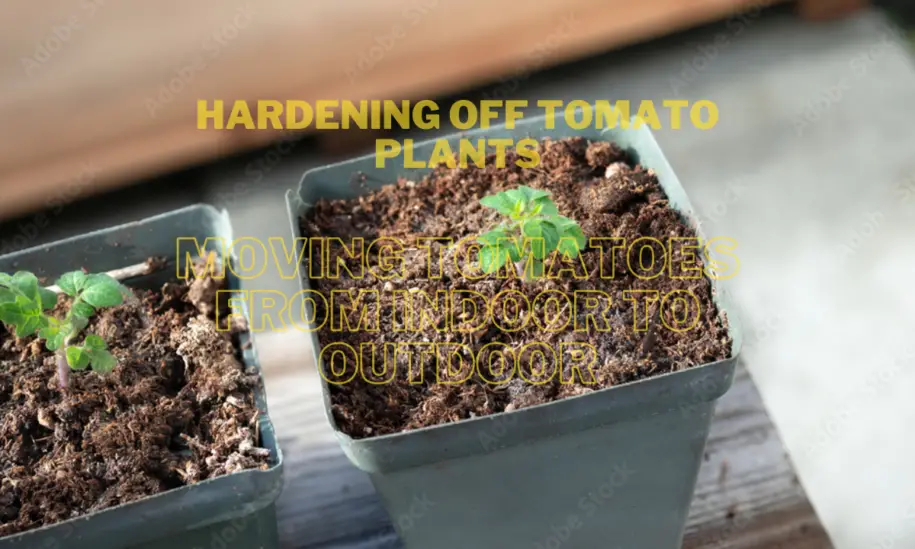Key Takeaways
- Hardening off gradually transitions tender seedlings from indoor conditions to variable outdoor growing.
- Begin hardening off once tomato plants have 4-6 true leaves and temperatures are above 50°F overnight.
- Move plants outdoors for just a few hours at first, slowly increasing over 7-14 days.
- Partially dry soil between waterings and protect from wind/rain during hardening off.
- Transplant hardened-off tomatoes 1-2 weeks after last frost once night temps stay above 50°F.
The spring weather is finally warming up and your tomato seedlings are thriving in their cozy indoor home. Now is the time to start planning for hardening off those tender plants to get them ready for transplanting outdoors. Hardening off is a critical stage in tomato plant development, but it’s a step that is often rushed or overlooked completely by eager gardeners.
Taking the time to properly harden off your tomato plants will ensure they transition successfully from the perfect conditions indoors to the harsher outdoor growing environment.
Follow this complete guide to hardening off tomato plants for tips and tricks to get your tomatoes off to their best start.
What is Hardening Off?
Hardening off is the gradual process of acclimating tender indoor seedlings to outdoor growing conditions. Seedlings start indoors and live in a protected, controlled environment often quite different from the variable weather and temperatures outside. Hardening off prepares them for these changes, allowing the plants to adjust slowly and build tolerance before the permanent move into the garden.
Some key changes plants must adapt to during the hardening-off period include:
- Lower Humidity: Indoor seedlings enjoy consistent moisture from regular watering and transpiration in enclosed spaces. Outdoors the air is drier.
- Wind and Rain: Sheltered indoor plants haven’t been exposed to wind or driving rain which can damage tender growth.
- Day Length: While indoors tomato plants enjoy consistent 14-16 hours under grow lights. Outdoors the days are getting longer in spring, with increasing sunlight.
- Fluctuating Temperatures: Indoors temperature hardly fluctuates day to night. Outside springtime temps can swing wildly, often dropping well below what seedlings are accustomed to.
- Intense Sun: Even when started in a sunny window, indoor seedlings aren’t exposed to the full intensity of direct outdoor sunlight. The UV light can damage tender leaves.
Hardening off is all about gradually introducing seedlings to these harsher conditions while protecting them from any sudden extreme changes that could shock the plant’s system. Take this process slowly and you’ll have stocky, robust transplants ready to thrive when placed in the garden. Rush it and your plants may fail to adapt and suffer permanent setbacks.
Why Hardening Off is Crucial for Tomatoes
Skipping the hardening-off process often leads to permanent setbacks with tomato transplants. The tender leaves and stems simply cannot withstand the intense sunlight, temperature fluctuations, lower humidity, and wind.
Here are some risks of transplanting tomato plants without hardening off first:
- Sunscald on leaves
- Wind damage to stems and stalks
- Wilting, stunting, or plant death
- Loss of blossoms and fruit sets
- Increased vulnerability to pests and diseases
- Reduced resistance to drought or floods
- Permanent stunting due to transplant shock
Hardening off is especially important when moving plants from a very controlled indoor environment to the variable outdoors. A greenhouse offers protection from the elements, so those plants may only need 7-10 days of hardening off before transplant.
Regardless of where they were started, proper hardening ensures your tomato plants establish quickly and start growing vigorously.
When to Start Hardening Off Tomato Plants
Timing is important! Young tomato seedlings should only be hardened off once they have 4-6 true leaves and an established root system. This usually occurs 4-6 weeks after sowing the seeds.
Hardening off too early limits the plant’s ability to withstand the stresses. Waiting too long means the plant may be root-bound or weakened by overcrowding with its neighbors.
Aim for these milestones before hardening off:
- 4-6 true leaves unfurled
- 6-10” tall with sturdy stems
- Well-established root system
- Actively growing (not stunted or root-bound)
Outdoor conditions must also be suitable for hardening off to begin. Wait for all danger of frost to pass and daytime temps around 70°F. The overnight low should not dip below 50°F.
How Long to Harden Off Tomato Plants
Most tomato varieties need 7-14 days of gradual hardening for the best results. This allows the plant to adapt to the changes in light, temperature, wind, and humidity.
- Seedlings from indoors need at least 14 days of hardening off.
- Plants from a greenhouse can often be hardened off in 7-10 days.
Factors like plant size, weather conditions, and variety can all impact the ideal hardening-off duration. Closely observe the plants and allow enough time for them to show signs of positive adaptation before transplanting.
I prefer to take a full two weeks, even for my greenhouse-grown tomatoes. This guarantees they are fully hardened off before going into the garden.
When to Start Hardening Off Tomato Plants
Time your hardening off period so that your tomato plants are ready to transplant 1-2 weeks after your average last frost date. This gives them a head start on the summer growing season so they have maximum time to mature a full crop.
If you started seeds indoors, begin hardening plants off around 4-6 weeks after germination when the seedlings have 3-4 true leaves. For transplants bought from a nursery, start 1-2 weeks after bringing them home.
Monitor the daily temperature forecast and nighttime lows before exposing tender plants. Ideally, begin hardening off once overnight lows are maintaining 50 ̊F/10 ̊C or warmer. Fluctuating temps in the 40s to 60s F/5-15C are fine during daytime hours at this stage. Just bring plants back indoors if it drop below 40 ̊F/4 ̊C to prevent cold damage.
Signs your tomatoes are ready for hardening:
- 6-8 weeks old – Seedlings should have 4-6 true leaves.
- Stocky stems – Avoid leggy, weak plants that can topple in the wind.
- Thriving indoors – Leaves are robust and green before being exposed to elements.
How to Harden Off Tomato Plants Step-By-Step
Follow these steps for a smooth transition from indoor coddling to outdoor growing:
Step 1. Move Plants Outdoors for Just a Few Hours
Choose a location protected from wind and full sun like a porch, carport, or shaded patio. Select a mild day, ideally when temps will reach 60-70 ̊F (15-21 ̊C). Place seedlings outside in the morning for just 2-3 hours before returning indoors for the night. Plants will benefit from the fresh air and gentle introduction to the outdoor environment.
Step 2. Gradually Increase Time Spent Outdoors
Over the next 7-10 days, slowly increase the duration plants remain outdoors by 2-3 hours per day. Start the day in the morning sun then move to dappled afternoon shade as exposure increases. Aim to have plants spending full 24-hour days out within a week to 10 days.
A cold frame or mini hoop house tunnel provides extra protection and creates a more gradual overnight transition. Just don’t forget to ventilate on sunny days! Make sure plants aren’t exposed to any temperatures below 45 ̊F/7 ̊C which can damage growth.
Step 3. Allow Soil to Partially Dry Between Waterings
Plants should be checked and watered daily while hardening off. But allow the soil surface to dry out slightly between waterings, so it’s just lightly moist. This encourages roots to grow deeper searching for water, increasing their resilience. Don’t allow plants to wilt which adds unnecessary stress. Just taper off saturation gradually.
Step 4. Protect From Wind and Rain Storms
If harsh winds or heavy rain are forecast, provide some cover for tender plants. A cold frame, light garden fabric row cover, or mini plastic tunnel are handy for temporary protection. Make sure not to restrict airflow to prevent fungal disease. Remove any coverings first thing in the morning on sunny days.
Step 5. Harden Off for 10-14 Days
Keep tomato plants outside in their hardening-off spot for 10-14 days unless bad weather occurs. This gives them ample time to transition and build tolerance to outdoor conditions. When nighttime lows have stabilized above 50 ̊F (10 ̊C) your hardened-off tomato plants will be ready for planting!
Transplanting Hardened-Off Tomatoes to the Garden
After 7-10 days of hardening off, tomato plants are ready for their permanent home in the vegetable garden. Follow these tips for a successful transplant:
- Pick a sunny spot. Tomatoes need a minimum of 6-8 hours of direct sun daily.
- Space plants properly. Allow 18-36 inches between tomatoes depending on variety.
- Dig holes wider/deeper than root balls. Tomato roots grow deep.
- Plant at the same depth as in containers for proper stem hardening.
- Water immediately and regularly until established (about 2 weeks).
- Consider mulching to retain moisture and suppress weeds.
- Provide support. Stake, cage, or trellis tomatoes right away to prevent leaning and damage.
Common Hardening Off Mistakes and How to Avoid Them
| Mistake | Don’t | Do |
|---|---|---|
| Sudden Move to Full Sun | Place delicate indoor plants straight into direct outdoor sunlight. | Start in shade/filtered sun and gradually increase light over a week or more. |
| Letting Plants Dry Out | Assume rain provides sufficient water for hardening plants. | Check soil moisture daily. Water thoroughly if dry 1-2 inches down. |
| No Protection From Wind | Allow whipping winds to batter tender tomato transplants. | Shelter plants from gusts, slowly exposing to breezes over time. |
| Cold Night Exposure | Leave tomatoes outdoors overnight if temperatures drop below 45°F. | Bring plants indoors or use cloches/cold frames overnight until the soil warms. |
Few Tips for Successful Hardening Off
Follow these tips in addition to the step-by-step hardening-off process:
- Check plants daily for signs of stress like wilting, yellowing leaves, and stunted growth. Delay transplanting if any are struggling.
- Move plants back indoors or offer protection if temperatures drop below 45 ̊F/7 ̊C. Frost will damage tender plants.
- Water when the soil surface just begins to dry out. Don’t saturate or allow to completely dry.
- Fertilize weekly with a dilute, complete organic fertilizer to nurture plants during the hardening-off transition.
- Inspect closely and remove any pests before moving plants outside. Outdoor conditions favor rapid pest reproduction.
- Ensure plants spend nights outdoors 2-3 days prior to transplanting so they don’t go into shock.
- Transplant on a mild, cloudy day to reduce stress. Water in the well and provide shade until established.
- Allow extra hardening off time if transplanting during a cool spell. Wait for soil and air temperatures to be ideal before planting.
Frequently Asked Questions
Q: Should you harden off tomato plants grown from seed?
A: Yes, all tomato plants grown from seed indoors should be hardened off before transplanting regardless of variety. The controlled indoor environment differs too much from outdoor conditions. Take 7-14 days to slowly transition indoor seeded tomatoes for best results.
Q: Can you harden off tomato plants in full sun?
A: Tomatoes should not be hardened off in full sun immediately – they need gradual exposure to prevent sun scald on tender leaves. Start plants in just 2-3 hours of early morning sun for a few days, slowly increasing afternoon shade exposure over a week or two until acclimated.
Q: Is hardening off necessary for greenhouse-grown tomato transplants?
A: Greenhouse conditions can still differ from outdoor growing, so hardening off is recommended. The procedure may take just 5-7 days for greenhouse plants vs. 10-14 days for indoor seedlings. But some gradual transition is still beneficial.
Wrapping up!
Hardening off tomato plants is an essential ritual for home gardeners who start seedlings indoors. By slowly introducing outdoor conditions over 7-10 days, you properly acclimate tomato plants to the elements they’ll face once permanently planted.
Avoid common mistakes like drastic light/temperature changes, untreated wind damage, and premature blossoms. Follow the tips above, and you’ll discover that hardening off isn’t difficult. In fact, it sets your tomatoes up for health and bountiful harvests.
The key is patience. Resist the urge to rush the process. Allow those leafy green tomatillos, romas, cherries, and heirlooms to properly transition. Your harvest depends on it!
Now that you know how to harden off like a pro, it’s time to get growing. Monitor the weather, prep your seedlings, and get ready to move those beauties outdoors. Enjoy the fruits of your labor!



